Picking the Right Size and Resolution for Your Smart TV
April 25, 2018
The first thing you have to do when picking the right size and resolution for your Smart TV is choose the size that you want. You have to see the size of the room the TV will be in and if it will have enough space for the size it as well as how close to the TV that you will be sitting. It really does not make sense to purchase a bigger smart TV when you will be sitting close to it or buying a smaller one when you will be sitting further away. Also, check out the size of the TV in terms of other things on the wall around it like pictures, as you do not want that wall to look cluttered.
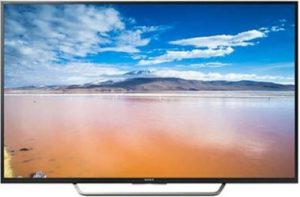
The thinness of smart TV’s is coming more into the picture these days. There are higher prices for the new smart TV’s, and one of the reasons is that they are thinner. You only need a very thin TV if you want to mount it to the wall. If you do not plan to do this than a TV that may have more depth may be the right choice, as it will not only likely be less expensive, but it can make it more stable.
When you pick the size of your smart TV, it really depends on your tastes and the area of your living space you want to place it. One way that you can really get a good measure on how the TV will look is to find the size and then using the dimensions make a cardboard cutout. Then place it on the wall or wherever you want to put it to see how it may fit. Many times, the bigger the TV, the better it can be, but also the bigger TV’s can be more expensive as well.
Resolution
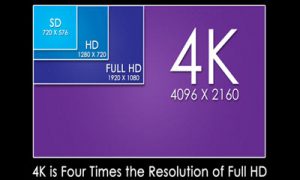
When it comes to the resolution of your TV 4K, Ultra HD, is something that you should definitely have. However, if you are looking into buying a smaller TV, 40 or fewer inches, than an older model with HD can do the trick, and on top of that, you will save quite a bit of money. Also, the resolution on a smaller model TV is not very noticeable and may not be worth the price. In terms of the bigger TV’s 8K ones are not far off, but that will be for very large TV’s so getting a 4K is the best option to take for your viewing pleasure.
Inputs are Key
You also need to see how many and what types of inputs you will need for your smart TV, as you want to make sure you have the inputs for your devices and cables you will be using. Also, check the specs on the HDMI is key, and you can generally find this information in the TV’s manual as well as online. HDMI 1.4 has limits of 4K 30 frames per second. For 60fps 4K you will have to have 2.0 or higher HDMI, and in order to get total HDR support, you will need HDMI 2.0a or later.
Things Your Smart TV Can Do
April 16, 2018
Many times, people buy a smart TV since they are the newer ones on the market, but they do not know what the things your Smart TV can so. A smart TV is a combination of a computer and TV, and there are many things that it can offer you. Here are some you may not be aware of.
Live Feed Streaming

Live feeds can be some of the best videos on the Net these days, as you can see many things live as they happen such as a storm or the people traffic in Times Square in New York City. For smart TV’s that are compatible Ustream is a great application to have to stream videos live and for free as well. This app allows you to watch a lot of live videos from the around the world and it will not cost you a dime. There is also the Earthlapse app for Apple TV users, which allows users to check out views of the planet earth that are first hand from the International Space Station. From sporting events to live events around the world, live streaming is the way to watch them on your smart TV.
Browsing the Web
Obviously, your smart TV will have a bigger screen than your desktop computer and laptop, which is why it is popular for people to use an HDMI cable in order to browse the web. Hooking up this cable from your computer to your smart TV will allow you web browsing mirroring what your computer does but on your TV. Just look for the HDMI area on the smart TV using the remote control and then simply hook up the cable from TV to computer. There are a lot of smart TV’s on the market today that also has a built-in web browser to cruise the Internet, and there is no cable required. The connection time is quicker on a smaller computer, but you still are browsing on a much bigger screen.
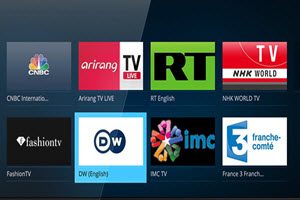
No Need for Console
You can play video games using a smart TV, and you do not even need a console. There are games that you can download through apps directly onto a smart TV. No gaming console is needed and while you need to make adjustments, especially for more complex games, but you can play the games and not only that, again, the gaming action may be better with a bigger screen. There are also special streaming game services such as PlayStation Now, which can give the best gaming experience when using a smart TV.
The Rise of Social Media
Social media is HUGE these days whether it is Facebook or Twitter and the feeds are addictive for many people. Most of the major brands of smart TV’s now have applications specifically dedicated for social media platforms. This is especially the case for the bigger ones mentioned of Facebook and Twitter.
A few of the other things that you can do on your smart TV that you may not be aware of are using the many fitness options, always being on top of the weather, and listening to live FM radio feeds from around the world.
Best Televisions of 2018
March 12, 2018
2018 is off to a fantastic year for television. Those who are looking for a cinematic experience will find some great choices waiting to be unearthed, and with picture quality that is stunning, vibrant and rich in colour, the viewing options are boundless.
We thought it ideal to highlight a few of the best releases so far in 2018. This includes the best 4K T.V, the best picture quality and the best value. Read on and see what awaits.
Best 2018 4K TV:
The LG E7 OLED is the best 4k of the year as it offers the most lifelike cinematic experience. Coming in at 65 inches, this is one that should be at the top of your list. The TV has a fantastic picture quality due to its OLED 4K display.
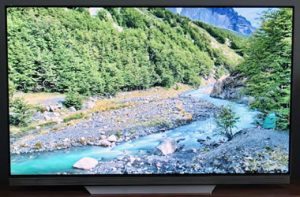
One nice thing about the LG E7 is that it is compatible with all formats including HDR10, Ultra HD and Premium Dolby Vision. The sounds produced from this TV are exceptional, yet it goes well beyond its picture quality and sound symbol, it offers “picture-on-glass” and plenty of services and apps, making this not only the best 4K TV of the year but a smart one at that.
Best Quality: Sony Bravia OLED
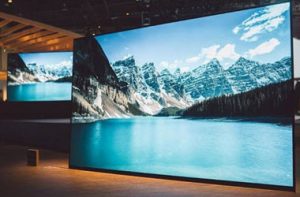
The Sony Bravia OLED TV is truly a superior T.V thanks to its high-quality sounds and Android features. Coming in at 65 inches, it offers crystal clear pictures and multiple angles for your viewing pleasure. As with most other sets of today, the Bravia the usual HDR formats so that colours are more intense and the picture is brighter. As one would expect with Sony, the sounds emanating from this set are outstanding and certainly do not disappoint as it uses Sony’s advanced Acoustic Surface technology.
Best 4K TV For Your Money: TCL Roku TV
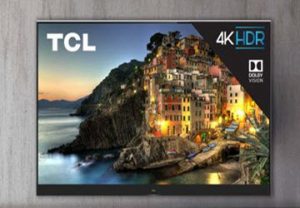
If you budget conscious but want the most for your money, then the TCL Roku TV is perfect for the budget conscious buyer as it provides excellent value for the money. Coming in at 55 inches, it has all that is needed for picture quality and high-def sounds, and obviously, includes ROKU TV.
Quick TV Buying tips
Buying a new television can be a bit stressful when you consider all the options today. We thought a few tips might be in order to help guide you in the polluted space on home entertainment so that the dollars you spend are spent wisely.
When selecting a new TV, make sure the set is 4K as you will see a superior quality in the picture, and as this is more common today, it is affordable.
Think carefully about the screen size as today you have loads of choices but buying one that is too large for the space you plan to put the TV is not ideal and will deter from the quality of your time spent watching television.
Lastly, consider the price and how often the television refreshes as the higher this number, the better your experience. Do not purchase any set that is less than 120 Hz rate.
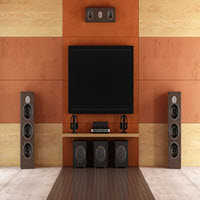
Planning your Home Theater
February 12, 2018
Long gone are the days when if you wanted to watch a film in style, you had to haul yourself (and your family) off to the cinema. Today, most of us either have or have given thought to having a home cinema. If you haven’t set one up yet (or even if you have but the setup doesn’t work for you), there are a couple of things you should consider when planning your home theater to get the most out of your experience.
Planning your home theatre
The shape of the room which will play host to your home theatre is actually, rather important. There is no one-shape which you must have, but you need to plan everything around the shape of that room.
For starters, where are the windows and what kind of light comes in through them, and when? If the sunlight shines in through your windows at a time when you don’t watch television, it’s hardly a big deal. However, if the sun shines brightly and reflects onto your screen when you want to watch a film, that’s a problem. You could rectify this issue with thick curtains or blinds but situating your home theatre away from the windows’ glare is an alternative if you don’t want to fork out more cash.

Next up you need to look at your walls, particularly if you’re going to mount a television on a wall or use a projector. If you’re going to put your TV up on the wall, it needs to be a stable, strong wall. You’ll also want to make sure that if you use a projector, you have white walls.
If your home theatre room suddenly looks too dark, there are ways to fix that, too. LED lights are ideal, since they don’t give off much heat or glare, and are cheap as chips to run. Setting some up around the back of your television set is handy, especially for that cosy night in front of the box.
The finishing touches
Aside from the DVD/Blu-Ray player, you’re also going to want to think about internet capabilities. Many of us watch Netflix and other streaming services, so wherever you put your Smart TV, you’re going to need to be in the range of your router. Most modern routers cover wide areas, but you still want your theatre as close as possible to the action.
Similarly, the layout of the couches or sofas must also be in the right spot. You want as many directly in front of the television as possible but not too close or too far. The bigger the Smart TV, the further away you can be.
Don’t worry too much about sound. With a decent home theatre, being far away from the television isn’t a problem. Most of the best home theatres have four standing speakers. If they are “towers”, you can place them on the floor, or you can elect to put them up on the walls if they are smaller and mountable. Either way, you’re going to want them to surround your “home theatre area” not necessarily be pegged to the four corners of the room. This way, your audio experience is as immersive as possible.
5 Important Elements to Consider when Buying a Smart TV
November 23, 2017
5 Important Elements to Consider when Buying a Smart TV
Buying a new TV is not one of the easiest things you can do. There are so many manufacturers and brands out there, all with varying price tags. The salespeople don’t make the experience any easier as they use alien-sounding terminologies and hyperbolic claims explaining the graphics quality. These facts may push you to seek information from the internet. Unfortunately, you will get conflicting facts and opinions and other meaningless jargon that will make your research even worse.
The process of buying a new smart TV raises a lot of questions as you try to compare the features of different brands. All the information gathered can easily result in purchasing a television that is technologically inferior. However, all is not lost and you don’t need to give up looking for the most appropriate TV. Considering the following factors will help you purchase the right smart TV without compromising quality or your budget.
 The Preferred Mode of Display
The Preferred Mode of Display
When it comes to displaying mode, you have three options to choose from; Plasma, LCD, and LED. For a long time, Plasma TV’s were considered the best performers in terms of color output and superiority of dark levels. Nowadays that is no longer the case as the latest LED’s feature advanced panels that help produce brighter and clearer pictures than the blacks. However, if you want a basic upgrade for your TV, you can buy an LCD but if it’s a major one, then the plasma will do. LED on the other hand is the best choice if you want to strike a balance between visual output and looks.
Quality of the Graphics
Picture quality is the most significant features that every buyer should consider when buying a TV. When buying, you need to imagine how the pictures will display after considering factors such as black levels, frame rate, color output, input lag when gaming through a console, and color gloss.
HD or 3D Smart TV?
Buying a TV is an investment and you want to make sure your investment remains trendy for long. There are some people who consider the 3D layer in TV’s as an expensive whatsit while others see it as a necessary add-on. The truth is, 3D layer gives you a better viewing plus it will reach a point in future when most smart TVs will include this feature.
Cost and After Sales Service
Before buying a smart TV, make sure you compare price tags of different brands and their qualities. Analyze different deals and the after-sales benefits associated with each deal. Also, visit consumer forums and compare customer services of various manufacturers. There is nothing more irritating than getting an issue with your brand new TV but the manufacturer is out of reach to offer assistance.
Features of Smart TV
If your only interest is viewing TV, then a basic HDTV might do. However, a smart TV has additional features that make it more interesting. It comes with Smart Share, Wi-Fi, DLNA, and Wi-Di. In addition, you can make it the central connection point for many gadgets within your home.
While there so many other factors that you can consider when purchasing a TV, the above five matter the most. There are some people who will want to buy a big screen, but it meaningless if it has terrible graphics display. The other features are a matter of preference.